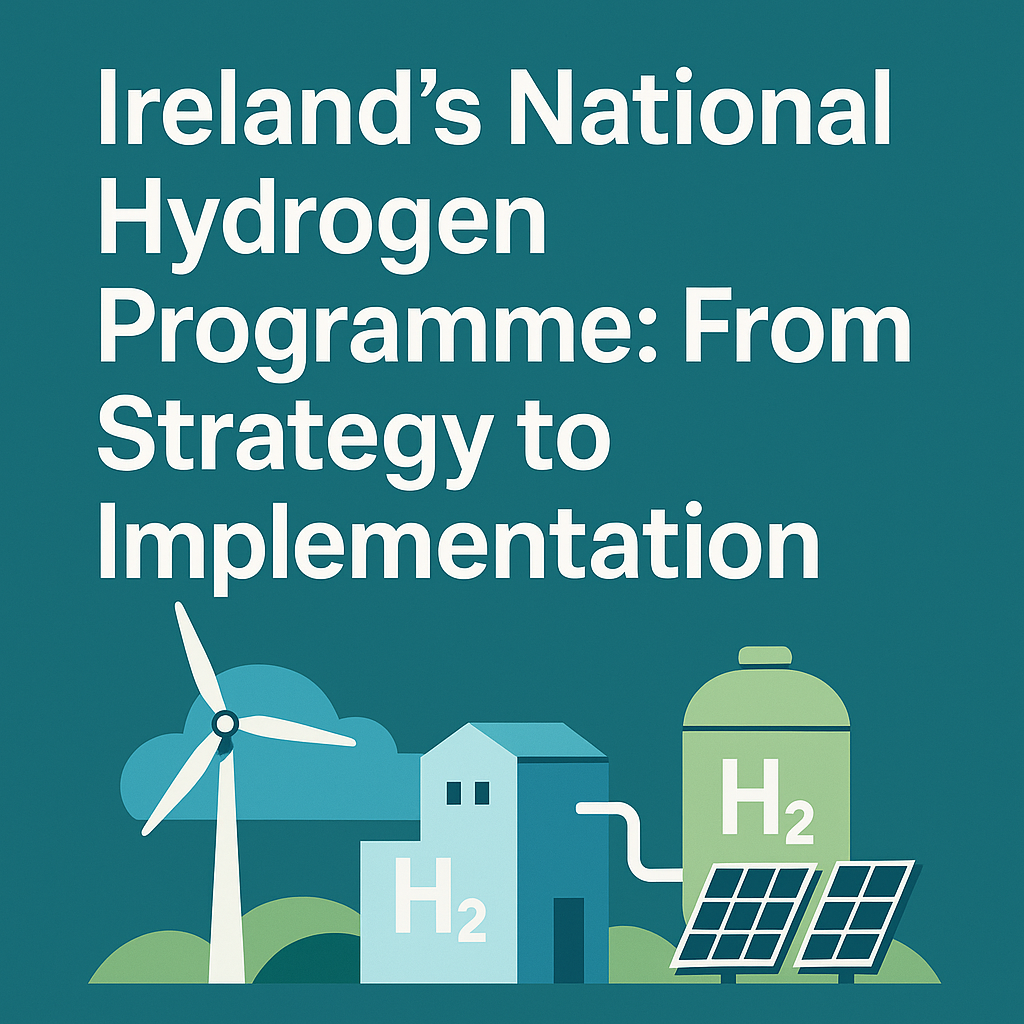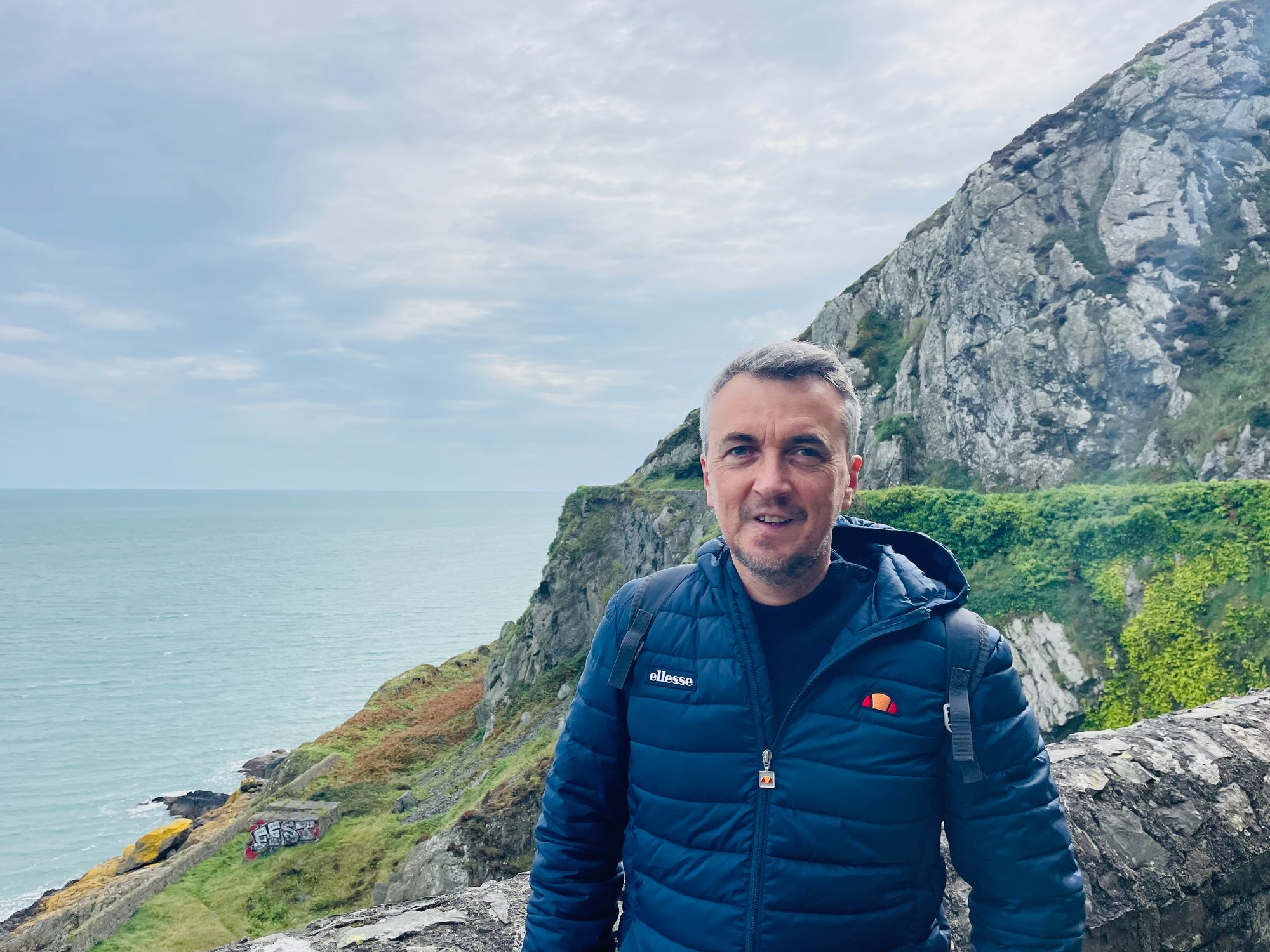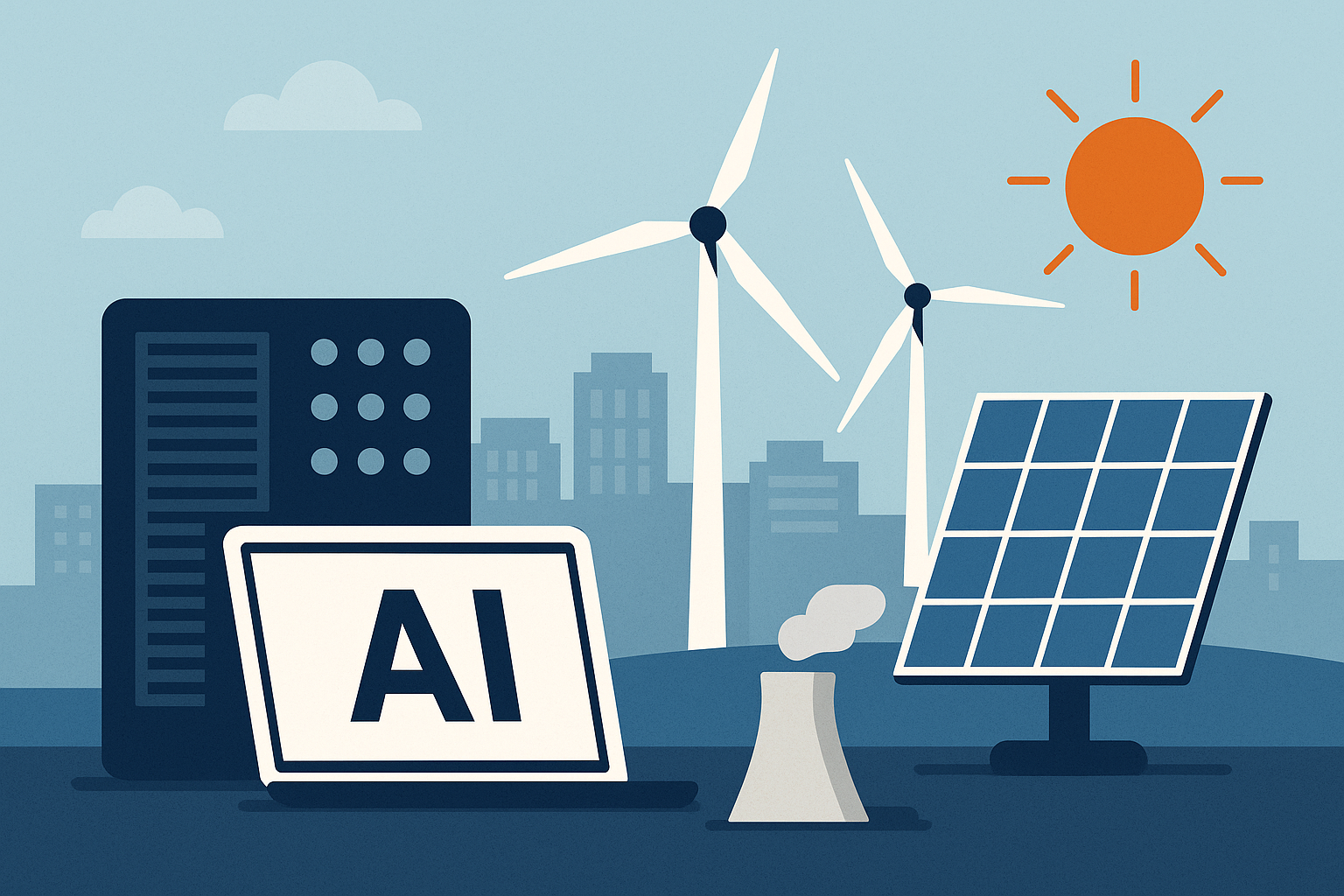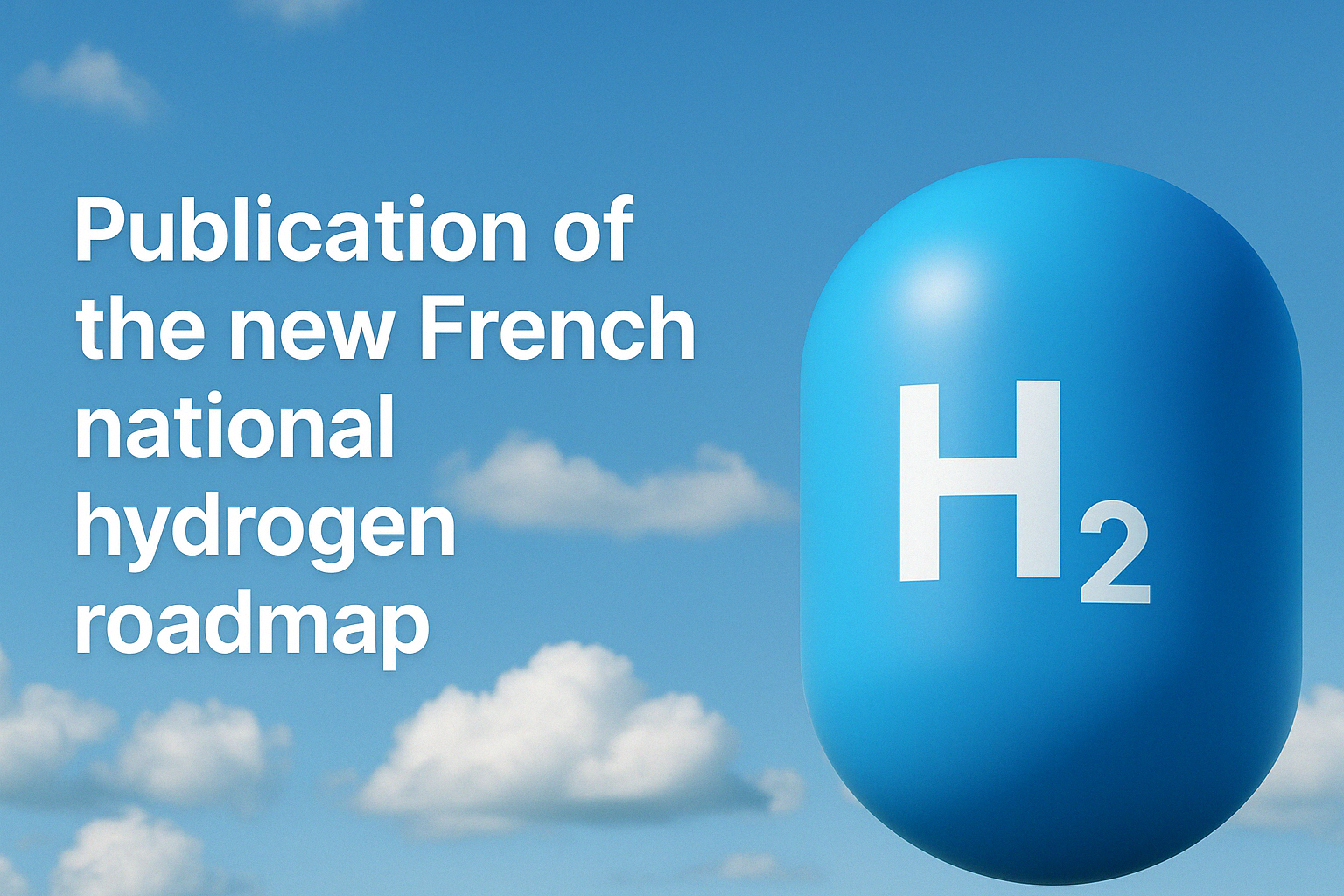Ireland’s National Hydrogen Programme: From Strategy to Implementation

Ireland has published its National Hydrogen Programme Implementation Plan (2025), turning strategy into delivery. It sets how hydrogen will be regulated, integrated into the energy system, and supported by industry and research, positioning Ireland in Europe’s hydrogen economy.
1. Introduction: Ireland in the Global Hydrogen Transition
Hydrogen has become one of the defining questions of the global energy transition. Once a niche industrial input, it is now widely seen as a flexible energy carrier that can complement electrification, store renewable power over long durations, and provide a low-carbon fuel for heavy transport and industry. Governments across the world are experimenting with hydrogen as both a climate tool and a lever of energy security.
For Ireland, the hydrogen agenda is inseparable from its legally binding climate targets: a 51% reduction in emissions by 2030 and climate neutrality by 2050. The country’s energy system will rely heavily on offshore wind, but the variability of this resource makes hydrogen attractive as a buffer and as a pathway to new industrial opportunities. The National Hydrogen Strategy (2023) set out the vision. The National Hydrogen Programme Implementation Plan (2025) now provides the delivery framework, detailing actions on regulation, infrastructure, and markets.
Ireland’s plan sits firmly within the European context. The EU Hydrogen Strategy (2020) provided the foundation, while the REPowerEU plan (2022) doubled ambition to 20 million tonnes of renewable hydrogen annually by 2030. Subsequent delegated acts (2023) defined strict criteria for renewable hydrogen, and in 2025 the EU added a methodology for low-carbon hydrogen alongside a Hydrogen Mechanism to connect buyers and suppliers. For Ireland, aligning with these frameworks is non-negotiable if its hydrogen is to be certified and tradable across Europe.
Regionally, Ireland works with the UK and Northern Ireland on standards and infrastructure, engages in bilateral dialogue with Germany, and collaborates with France, which updated its hydrogen strategy in 2025 (targets: 4.5 GW by 2030, 8 GW by 2035). Within the North Seas Energy Cooperation, Ireland contributes to a shared offshore and hydrogen framework. Globally, competition is intense: the US subsidises production under the IRA, China scales up manufacturing, Japan and South Korea secure supply chains, and the Middle East builds export hubs. Ireland cannot match their scale, but it can offer trusted renewable hydrogen, certified under EU rules, and leverage its offshore wind potential.
In short, hydrogen is not an end in itself but a means to achieve Ireland’s climate and energy goals and connect the country to Europe’s emerging hydrogen economy. The Implementation Plan marks the shift from aspiration to execution.
2. The National Hydrogen Programme: Governance and Implementation
Ireland’s National Hydrogen Programme Implementation Plan (2025) is not merely a policy statement. It is a framework for delivery, combining governance mechanisms, operational detail, and a demanding timeline of milestones stretching to 2030 and beyond.
2.1. Governance and coordination
At the centre is the National Hydrogen Programme Taskforce, chaired by the Department of the Environment, Climate and Energy (DCEE). It brings together:
- Government departments: DCEE (lead), DETE, Transport, and Taoiseach.
- Agencies/regulators: SEAI, CRU, NSAI, MARA, NORA, Gas Networks Ireland.
- Industry: represented via an Industry Engagement Subgroup, meeting twice yearly.
Supporting the Taskforce is a Programme Management Office (PMO), tasked with consolidating reports, monitoring risks, tracking milestones, and ensuring continuity.
The Taskforce operates through three Working Groups (WGs):
- WG1 – Safety & Regulations: certification, EU transposition, underground storage, safety roadmap.
- WG2 – Infrastructure & Systems: gas blending, hubs, long-duration storage, integrated planning.
- WG3 – Markets & Commercialisation: Hydrogen Innovation Fund, business models, transport, exports, industrial demand.
2.2. Key actions and milestones (2025–2030)
The Implementation Plan defines a sequence of actions for each Working Group.
Safety & Regulations (WG1)
- Establish a certification system aligned with EU RFNBO rules by 2026.
- Publish a hydrogen safety roadmap in 2025 and designate regulators by 2026.
- Conduct geological studies on underground hydrogen storage (2025–2028), with a regulatory framework by 2028.
- Review planning and permitting regimes by 2026.
Infrastructure & Systems (WG2)
- Prepare a gas blending roadmap by 2026, leading towards 100% hydrogen compatibility post-2026.
- Deliver renewable surplus mapping (EirGrid, 2025).
- Conduct a green energy cluster feasibility study (DETE, 2025).
- Complete strategic hub mapping in 2026, with a policy report in 2027.
- Publish a long-duration storage roadmap by 2027.
Markets & Commercialisation (WG3)
- Establish a Hydrogen Innovation Fund: strategic assessment (2025), business case (2026), operational by 2028.
- Develop business models for offshore hydrogen, targeting 2 GW of electrolysis by 2030.
- Deploy hydrogen refuelling stations in line with EU AFIR requirements by 2030, alongside maritime and aviation pilots.
- Conduct export feasibility studies (pipelines, ammonia, e-fuels) from 2025 to 2027.
- Map industrial demand (cement, chemicals, data centres) 2025–2027.
- Publish a roadmap for net zero dispatchable power by 2028.
2.3. Annual cycle and implementation logic
The Implementation Plan establishes a strict annual rhythm of engagement:
- The Taskforce meets quarterly.
- Working Groups meet six times per year.
- The Industry Subgroup convenes twice annually.
- An annual review consolidates progress and adapts milestones.
This cycle ensures the Programme remains iterative, flexible, and capable of adapting to evolving technologies, European regulation, and market conditions.
3. Industrial and Research Opportunities
The National Hydrogen Programme Implementation Plan (2025) recognises that the success of Ireland’s hydrogen pathway depends not only on government action but also on the mobilisation of industry and the research community. For this reason, the Plan includes dedicated measures to engage companies, utilities, and academic institutions, and to ensure that opportunities for innovation are systematically identified and supported.
3.1. Industry engagement
An Industry Engagement Subgroup is formally established as part of the governance framework. Meeting twice annually, it provides a structured channel for dialogue between the Taskforce and market actors. Through this mechanism, companies are invited to give feedback on barriers, identify potential opportunities, and inform the design of future actions.
In addition, several of the actions contained in the Implementation Plan are directly linked to industry participation. For example, the Hydrogen Innovation Fund is explicitly designed to co-finance demonstration projects, lowering risks for private investors and stimulating market development. The Plan also notes that feasibility studies on hydrogen hubs, export routes, and blending options will require close cooperation with utilities, network operators, and industrial users.
3.2. Export and commercial opportunities
The Plan highlights that Ireland’s offshore wind potential creates the possibility of hydrogen exports. To assess these opportunities, it foresees dedicated studies on export feasibility (covering pipelines, ammonia, and e-fuels) under the remit of Working Group 3. These studies are framed as necessary steps before any commercial export strategy can be adopted, ensuring that policy choices are based on evidence and aligned with European requirements.
3.3. Research and innovation
The Implementation Plan also recognises the role of the research community. It mandates ongoing cooperation with academic institutions to identify knowledge gaps and commission targeted studies. In particular, Action 18 provides for systematic engagement with universities and research centres, ensuring that the Taskforce can benefit from independent expertise and that Ireland remains aligned with developments in European research programmes.
The areas flagged in the Plan for research input include:
- analysis of supply and demand scenarios for hydrogen to 2050,
- technical studies on long-duration storage,
- modelling of system integration across gas, electricity, and hydrogen networks,
- and horizon scanning to capture emerging international developments.
3.4. Early projects and demonstration
The Plan foresees that early demonstration projects will be supported as a way of building experience, testing regulatory frameworks, and providing lessons for future deployment. These are expected to be funded partly through national mechanisms (such as the Hydrogen Innovation Fund) and partly through European programmes. While no specific projects are listed, the Plan underlines their importance for market creation and knowledge generation.
4. Challenges and Conditions for Success
The National Hydrogen Programme Implementation Plan (2025) is ambitious in scope, but its delivery will depend on Ireland’s ability to overcome a series of structural challenges. The Plan makes clear that success is not only about launching projects but also about creating the enabling conditions that will allow hydrogen to develop as a functioning market.
4.1. Infrastructure readiness
A central challenge is the preparation of infrastructure. Hydrogen requires a complete value chain of production, storage, transport, and end-use facilities. In the Irish context, this means:
- adapting the gas network to allow hydrogen blending and, in the long term, conversion to 100% hydrogen;
- developing strategic hubs that can connect offshore wind resources to industrial users and, potentially, export routes;
- ensuring adequate long-duration storage, both geological and above-ground, to provide flexibility in a system dominated by variable renewables;
- and aligning with the electricity grid, which must integrate large volumes of offshore wind and support electrolyser deployment.
The Plan stresses that without timely investment and planning, bottlenecks in infrastructure could delay progress and increase costs.
4.2. Regulatory clarity
Regulation is another critical condition. The Plan highlights the need to transpose the EU Hydrogen and Decarbonised Gas Market Package by 2026. This will involve designating a Hydrogen Network Operator, establishing the rules for hydrogen network operation, and ensuring Ireland’s full participation in the European governance structure.
In addition, Ireland must establish a system for certifying renewable hydrogen in line with EU RFNBO rules, including guarantees of origin and sustainability criteria. Without regulatory clarity and certification, hydrogen produced in Ireland would not qualify for EU targets or be tradable in European markets.
4.3. Financing the transition
Hydrogen projects are capital-intensive and, at this stage, carry significant commercial risks. The Plan notes that a combination of public and private funding will be required to stimulate investment. Mechanisms such as the Hydrogen Innovation Fund will be key to lowering risks for early projects. In parallel, participation in European programmes—including Horizon Europe, the Connecting Europe Facility, and the Innovation Fund—will provide access to additional resources.
The Implementation Plan also underlines the importance of developing viable business models for hydrogen production, storage, and end-use. Without these, projects may struggle to attract private capital even if technical feasibility is demonstrated.
4.4. Skills and public acceptance
The Plan recognises that hydrogen will require new skills across multiple domains: electrolysis, gas network operation, safety engineering, system modelling, and project management. Building this workforce will depend on cooperation between government, industry, and the education sector.
Public acceptance is also identified as a condition of success. The Plan foresees a safety roadmap and standards development process, designed to ensure that hydrogen projects meet the highest safety requirements. Clear communication and transparent regulation will be essential to build trust among communities where infrastructure and facilities are developed.
4.5. Balancing domestic and export objectives
Ireland’s offshore wind potential creates opportunities for hydrogen exports, but the Plan emphasises that this must be balanced with domestic needs. Hydrogen should contribute to Ireland’s own decarbonisation targets, particularly in sectors where electrification is not sufficient, such as heavy transport and certain industries. At the same time, export routes must be explored to ensure that Ireland can contribute to Europe’s wider energy transition.
The challenge will be to manage this balance transparently, with clear criteria for allocating renewable electricity to hydrogen production and for prioritising domestic versus export use.
In summary, the Implementation Plan identifies five key conditions for success: infrastructure readiness, regulatory clarity, financing, skills and public trust, and a balanced approach between domestic decarbonisation and export. Each represents a significant challenge, but together they define the pathway by which Ireland can move from strategy to a functioning hydrogen market by 2030.
5. Franco-Irish Perspectives
Although the National Hydrogen Programme Implementation Plan (2025) is focused on Ireland’s domestic priorities, it also highlights the importance of European cooperation. Among Ireland’s partners, France stands out as a country with aligned ambitions and complementary strengths.
5.1. France’s updated strategy
France first adopted a National Hydrogen Strategy in 2020. In 2025, it updated its targets to reflect both progress achieved and evolving market conditions. The revised objectives now aim for 4.5 GW of electrolyser capacity by 2030 and 8 GW by 2035, slightly lower than the previous figures but more closely aligned with industrial and financial realities.
The French strategy emphasises three main areas:
- the development of industrial hubs, particularly around Dunkirk in the north and Fos-sur-Mer in the south, where hydrogen will be integrated into steelmaking, refining, and maritime activities;
- the integration of offshore renewable energy with hydrogen production, with regions such as Brittany and Pays de la Loire exploring synergies between offshore wind farms and electrolysers;
- the promotion of transport applications, including hydrogen-powered trains, buses, and maritime fuels.
These priorities mirror many of Ireland’s own ambitions, creating opportunities for bilateral dialogue and cooperation.
5.2. Areas of potential cooperation
The Implementation Plan notes the importance of building partnerships with EU member states, and the Franco-Irish relationship offers concrete opportunities:
- Offshore wind and hydrogen integration: Both countries are investing heavily in offshore renewable energy and see hydrogen as a solution to manage variability. Joint research or pilot projects could explore hybrid offshore platforms combining generation and electrolysis.
- Maritime fuels: With Atlantic-facing ports, Ireland and France share an interest in developing hydrogen-based shipping fuels and bunkering infrastructure. Cooperation in this area would align with EU regulations such as FuelEU Maritime.
- Industrial clusters: Ireland’s plans for hydrogen hubs could benefit from lessons learned in French clusters, where integration with heavy industry is already underway. Knowledge-sharing could accelerate Ireland’s development while showcasing complementarity at EU level.
- Research and innovation: Horizon Europe and the Clean Hydrogen Partnership provide frameworks for collaboration between universities and research centres. Institutions such as University College Dublin, Trinity College Dublin, and the University of Galway could partner with French organisations like CNRS, Inria, and CEA.
5.3. Regional cooperation through NSEC
Beyond bilateral projects, both Ireland and France participate in the North Seas Energy Cooperation (NSEC). This forum, initially focused on offshore wind, has now established a working group dedicated to hydrogen. Through NSEC, Ireland and France can jointly contribute to the design of cross-border hydrogen corridors and offshore integration strategies.
Another link is the Celtic Interconnector, due online later this decade. Although primarily an electricity cable, it symbolises the strengthening of Franco-Irish energy relations and illustrates how infrastructure can serve as a foundation for future cooperation in hydrogen and renewable integration.
In summary, the Franco-Irish perspective underlines the potential for cooperation at three levels:
- Policy and regulation: sharing experience on implementing EU frameworks.
- Research and innovation: building joint participation in European projects.
- Industrial development: collaborating on offshore hydrogen, maritime fuels, and industrial hubs.
For Ireland, France offers both expertise and a strong place in the European hydrogen landscape. For France, Ireland provides complementary offshore resources and a partner in the North Seas region. Together, they can contribute to the emergence of a more integrated European hydrogen economy.
6. Conclusion
The National Hydrogen Programme Implementation Plan (2025) represents Ireland’s shift from ambition to structured delivery. It sets out how hydrogen will be certified, integrated, financed, and scaled, while engaging with industry and research.
Hydrogen is not a silver bullet, but it is a strategic complement to electrification: balancing offshore wind, decarbonising heavy sectors, and creating export opportunities.
If Ireland delivers on its milestones, it could move from pilots to a coherent hydrogen market by 2030, and by 2050 become a recognised player in Europe’s net-zero energy system.
Read the full plan :


